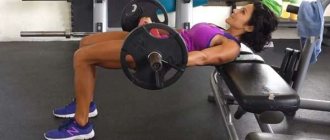Benefits of push-ups
Push-ups are the easiest and most affordable way to keep your shoulder and back muscles toned. This type of exercise is necessary to deliver oxygen to the brain.
With the help of push-ups, changing the position of the body in space and adjusting the exercise technique, a variety of muscle groups are trained.
Considering how energy-intensive this exercise is, we can safely say that push-ups are an ideal way to keep your weight in check.
The benefits of push-ups are significant for both men and women, and they include the following:
- strengthening the hands;
- development of endurance;
- improved blood circulation;
- strengthening the back and abs;
- working out the gluteal muscles;
- working out the pectoral muscles;
- development of the respiratory system;
- improved posture;
- increase in reaction speed.
Despite the fact that push-ups effectively train different muscle groups, you should create a complex that includes a certain number of other exercises.
A few words about the exercise
Push-ups are a basic exercise that is performed primarily with your own body weight. It is called basic because the biomechanics of movement involve the use of more than one joint and muscle group.
The main load when performing push-ups falls on the pectoral muscles and triceps. The muscles of the lower back, abs and gluteal muscles work as stabilizers. The shoulders are also involved in the movement.
Depending on the type of push-ups, the main load shifts to the pectoral or triceps.
Push-up variations:
- Push-ups with different hand positions.
- Push-ups with the body or legs raised.
- Push-ups with increased amplitude.
How many push-ups do you need to do to get results? It depends on your goal. To increase the number of repetitions in one approach and increase muscle mass, different training schemes are used, as well as other variations of push-ups.
How to start classes correctly
When starting to do push-ups, it is important not to overdo it. Don't overwork yourself on the first day.
It is important to perform push-ups correctly, only in this case the exercises will give significant results.
Basic mistakes when performing push-ups:
- Elbows too far apart. This is fraught with injury. Keep your elbows turned 45 degrees back.
- Lack of warm-up before training.
- Incomplete amplitude.
- Body deflection.
- Lifting the pelvis up.
- Incorrect breathing.
A proper push-up looks like this:
You can see the correct execution in the video.
Breathing is equally important when doing push-ups. Its frequency affects blood pressure, and therefore correct breathing is one of the fundamental factors. The rise should occur as you exhale; as you inhale, the body lowers.
In addition, proper motivation is important. One of the main requirements is consistency of execution; without it you should not expect a good result.
There are various push-up programs, following which you can achieve good results.
The most famous programs:
- 15 Week Push Up Program;
- 20-week push-up routine;
- “100 push-ups” program.
How many times should you do push-ups
For beginners who want to pump up and develop endurance, the “100 push-ups” program is ideal. But before you begin this program, find out what level of fitness you are at. This is not difficult to do, just do the maximum number of push-ups.
You can decide on further actions based on the data in the table:
| A week | Day | < 5 push-ups | 6-10 push-ups | 11-20 push-ups |
| Week 1 | Mon | 2-3-2-2, from 3 | 6-6-4-4, from 5 | 10-12-7-7, from 9 |
| Wed | 3-4-2-3, from 4 | 6-8-6-6, from 7 | 10-12-8-8, from 12 | |
| Fri | 4-5-4-4, from 5 | 8-10-7-7, from 10 | 11-15-9-9, from 13 | |
| Week 2 | Mon | 4-6-4-4, from 6 | 9-11-8-8, from 11 | 14-14-10-10, from 15 |
| Wed | 5-6-4-4, from 7 | 10-12-9-9, from 13 | 14-16-12-12, from 17 | |
| Fri | 5-7-5-5, from 8 | 12-13-10-10, from 15 | 16-17-14-14, from 20 | |
| Test | 16-20 push-ups | 21-25 push-ups | >25 push-ups | |
| Week 3 | Mon | 10-12-7-7, from 9 | 12-17-13-13, from 17 | 14-18-14-14, from 20 |
| Wed | 10-12-8-8, from 12 | 14-19-14-14, from 19 | 20-25-15-15, from 25 | |
| Fri | 11-13-9-9, from 13 | 16-21-15-15, from 21 | 22-30-20-20, from 28 | |
| Week 4 | Mon | 12-14-11-10, from 16 | 18-22-16-16, from 25 | 21-25-21-21, from 32 |
| Wed | 14-16-12-12, from 18 | 20-25-20-20, from 28 | 25-29-25-25, from 36 | |
| Fri | 16-18-13-13, from 20 | 23-28-23-23, from 33 | 29-33-29-29, from 40 | |
| Test | 31-35 push-ups | 36-40 push-ups | >40 push-ups | |
| Week 5 | Mon | 17-19-15-15, from 20 | 28-35-25-22, from 35 | 36-40-30-24, from 40 |
| Wed | 10-10-13-13-10-10 -9, from 25 | 18-18-20-20-14-14 -16, from 40 | 19-19-22-22-18-18 -22, from 45 | |
| Fri | 13-13-15-15-12-12 -10, from 30 | 18-18-20-20-17-17 -20, from 45 | 20-20-24-24-20-20 -22, from 50 | |
| Test | 46-50 push-ups | 51-60 push-ups | 60 push-ups | |
| Week 6 | Mon | 25-30-20-15, from 40 | 40-50-25-25, from 50 | 45-55-35-30, from 55 |
| Wed | 14-14-15-15-14-14 -10-10, from 44 | 20-20-23-23-20-20 -18-18, from 53 | 22-22-30-30-24-24 -18-18, from 58 | |
| Fri | 13-13-17-17-16-16 -14-14, from 50 | 22-22-30-30-25-25-18-18, from 55 | 26-26-33-33-26-26 -22-22, from 60 |
Training should take place no more than three times a week, this will allow the muscles to recover. If you don't think the 100 Pushups program is right for you, consider the 15 and 20 week programs.
15 week program
| A week | 1 | 2 | 3 | 4 | 5 | 6 | 7 | 8 | 9 | 10 | 11 | 12 | 13 | 14 | 15 |
| Approach 1 | 20 | 25 | 30 | 35 | 40 | 40 | 45 | 45 | 50 | 50 | 55 | 60 | 60 | 65 | 65 |
| Approach 2 | 20 | 25 | 30 | 30 | 35 | 40 | 40 | 45 | 45 | 50 | 50 | 55 | 60 | 60 | 65 |
| Approach 3 | 15 | 20 | 25 | 25 | 25 | 30 | 35 | 35 | 35 | 40 | 40 | 40 | 45 | 45 | 45 |
| Approach 4 | 15 | 15 | 20 | 20 | 25 | 30 | 35 | 35 | 35 | 40 | 40 | 40 | 45 | 45 | 45 |
| Approach 5 | 10 | 10 | 15 | 15 | 15 | 20 | 25 | 25 | 30 | 35 | 35 | 35 | 40 | 40 | 40 |
| Total | 80 | 95 | 120 | 125 | 145 | 155 | 180 | 185 | 195 | 215 | 220 | 230 | 250 | 255 | 260 |
20 week complex
| A week | 1 | 2 | 3 | 4 | 5 | 6 | 7 | 8 | 9 | 10 | 11 | 12 | 13 | 14 | 15 | 16 | 17 | 18 | 19 | 20 |
| Approach 1 | 20 | 25 | 30 | 30 | 35 | 40 | 40 | 45 | 45 | 50 | 50 | 55 | 60 | 60 | 65 | 65 | 65 | 70 | 70 | 75 |
| Approach 2 | 20 | 25 | 30 | 30 | 35 | 40 | 40 | 45 | 45 | 50 | 50 | 55 | 60 | 60 | 65 | 65 | 65 | 70 | 70 | 70 |
| Approach 3 | 15 | 20 | 25 | 25 | 25 | 30 | 35 | 35 | 35 | 40 | 40 | 40 | 45 | 45 | 45 | 50 | 50 | 55 | 55 | 55 |
| Approach 4 | 15 | 15 | 20 | 20 | 25 | 30 | 35 | 35 | 35 | 40 | 40 | 40 | 45 | 45 | 45 | 50 | 50 | 55 | 55 | 55 |
| Approach 5 | 10 | 10 | 15 | 15 | 15 | 20 | 25 | 25 | 30 | 35 | 35 | 35 | 40 | 40 | 40 | 40 | 45 | 45 | 50 | 50 |
| Total | 80 | 95 | 120 | 125 | 145 | 155 | 180 | 185 | 195 | 215 | 220 | 230 | 250 | 255 | 260 | 275 | 280 | 300 | 305 | 315 |
The number of push-ups depends on the goal. If the goal is to lose excess weight, then you should perform 15-20 push-ups per day in 5 sets.
How to learn to do a lot of push-ups
No matter how strange it may sound, in order to learn how to do a lot of push-ups at one time, you need to do a lot of push-ups. This means that during the day you need to do 1-2 endurance workouts.
How many push-ups should you do per day? As much as possible. Find out your current maximum number of repetitions and aim to increase this number by one repetition every day.
There is another way. Divide the workout into 5-6 approaches. In the first set, perform 80% of your one-time maximum repetitions, and in each subsequent approach add one repetition. Try to progress the load in each workout - this is the key to success.
Rep Increase Program
Let's say your maximum is 50 push-ups at a time. This means that the first set starts with 40 repetitions.
- first approach – 40 repetitions;
- second – 41;
- third – 42;
- fourth – 43;
- fifth – 44;
- sixth – 45.
Rest between sets for 30-60 seconds. If you can’t complete the program right away, don’t give up. Remember, you have to do as many push-ups as you can, and everything will work out.
Types of push-ups
If the “100 push-ups” program has been successfully completed, but you have no desire to quit, you have the opportunity to try other types of push-ups. This exercise has a large number of different variations.
Classic
A well-known type of push-up. This is what students do in schools.
Positioning of hands during classic push-ups: positioning of hands wider than shoulder level. Focus on your toes and palms.
As mentioned above, proper push-ups are the key to your success. Don't forget that there should be no arching in your back.
Knee push-ups
This type of exercise reduces the load on all muscle groups. This is an ideal option for beginners.
The starting position coincides with the position in classic push-ups, with the caveat that these push-ups are done with emphasis on the knees.
From a horizontal surface and from a wall
If you feel that your training is not enough even for push-ups from your knees, then wall push-ups are ideal for you.
The technique is simple. Starting position: facing the wall, hands positioned slightly wider than shoulder level. It is preferable to rest not on the entire foot, but solely on the toes. This will allow you to get the maximum benefit from the exercise.
Push-ups from a horizontal surface are quite difficult, especially when compared to push-ups from a wall. The surface can be either the floor or the bench.
Wide grip
Wide-grip push-ups put the main load on the pectoral muscles. If your goal is to pump up your chest, then you should focus on this type of push-ups.
Wide-grip push-ups are of medium difficulty level. They are not suitable for beginners.
When starting to do push-ups, you need to place your hands at a distance greater than shoulder level. The palms can be directed both forward and to the side. It is acceptable and even desirable to spread your elbows wide.
With a medium grip
This type of push-up puts most of the load on the triceps and deltoids.
Palms are located at shoulder level. The legs should be less than shoulder width apart from each other.
You can place your legs on an elevation - this will increase the load. However, if you want to reduce the load on the contrary, you should place your hands on a raised platform.
Narrow grip
When doing push-ups with a narrow grip, the main load is on the triceps muscle, as well as on the chest and deltoids. This movement is similar to the close grip bench press in terms of stress on the muscles.
You need to place your hands so that your thumbs and index fingers touch each other. Place your elbows as close to your sides as possible.
On one hand
One-arm push-ups develop the triceps muscles and forearms.
To perform this type of exercise, you need to have quite a lot of experience in sports, since push-ups on one arm are considered one of the most difficult.
The starting position differs from the classic version in the width of the legs. After taking the starting position, lift one hand off the floor and place it behind your back.
If you are trying this type of push-up for the first time, it is not a fact that you will achieve the full amplitude right away. To begin with, doing the exercise at full strength is not at all necessary.
With clap
Clapping push-ups use the same muscles as regular exercises.
The peculiarity of this type is that during the lifting process you make a sharp push and throw your body up. If other types of push-ups are used mainly as relief training, then these push-ups will help develop dexterity.
This exercise also requires preparation and experience. The danger of doing push-ups with clap is that you may not have time to clap and fall. To avoid this, you should first practice without clapping, simply lifting your body up.
On fingers
Finger push-ups are a fairly effective and unusual exercise.
When performing this type of push-ups, endurance increases, a huge number of very diverse muscle groups work:
- chest muscles;
- triceps muscles;
- forearms;
- back muscles;
- trapezius muscle;
- deltas;
- press;
- buttocks;
- calf muscles;
- hips.
These push-ups are a great way to prevent arthritis.
Hand position in this exercise is not a fundamental factor. Place your hands with a wide or narrow grip at your discretion.
Video about how to properly perform push-ups on your fingers.
If push-ups using your fingers are difficult, consider push-ups using your fists. Here the emphasis is not on the palms, but on the knuckles, turned perpendicular to the body.
With weights
Weighted push-ups are aimed at developing the pectoral, deltoid and triceps muscles. However, this exercise also works other muscles:
- press;
- leg muscles;
- intercostal muscles;
- back muscles.
Additional weights when doing push-ups are used to get a greater effect from training.
If you constantly train only with your own weight, then over time the effectiveness of your training will begin to fall. This occurs due to the body’s adaptation to the load, so over time it is better to increase the load, but gradually.
Typically, push-ups are done to gain muscle mass. Dumbbell push-ups are also suitable for greater muscle development. In addition to other muscles, they involve stabilizer muscles. A little more about this exercise.
Deep push-ups
If regular push-ups have begun to seem too simple to you, and you want to increase your range of motion, then deep push-ups will be an ideal option. Thanks to special supports for push-ups, you have the opportunity to make the exercise more difficult and increase the amplitude. However, you will not be able to gain muscle mass through such exercises.
Do not forget that the amplitude should be increased gradually. Otherwise, there is a risk of muscle strain or injury.
Push-up technique
Take a “lying position”, straighten your arms in front of you, feet rest on the floor, legs together. The chest, lower back and legs should be straight and in one line. When lowering, keep your elbows at a 45-degree angle relative to your body.
At the lowest point, slightly touch the floor with your chest, this way the muscles will stretch better, which means that the prerequisites for growth will be higher. At the top point, do not straighten your arms completely to maintain the load in the target muscle. Watch your breathing: exhale as you force, inhale as you stretch the muscle.
About hand placement
The wider the position of the arms, the more load goes to the pectoral muscles. However, setting too wide reduces the range of motion. Therefore, if you want to shift the emphasis to the chest, place your hands a little wider than your shoulders.
Narrow hand placement loads the triceps. If you want to pump them up, take the standard starting position, but clasp your hands in front of you, palm to palm. While lowering, try to keep your elbows closer to your body, this will pump up the inner head of the triceps, which gives the greatest volume to your arm.
| Rotating supports for push-ups allow you to change the position of your hands (redistribute the load between the muscles differently) and lower your body relative to your hands lower than exercises on the floor - thus “killing” the muscles even more with training. |
FAQ
People who have just started doing push-ups often have questions. Pay attention to the most common ones.
Is it possible to train more than 3 times a week?
If you are just starting classes, then training more than 3 times a week, and especially every day, is contraindicated. It is better to exercise according to special training programs, which were described above.
What should be the break between sets?
On average, the interval between approaches lasts one to two minutes. When performing the “100 push-ups” program, it is advisable to rest for no more than 90 seconds. If the gap is too long, the muscles will lose heat.
I couldn’t complete all the planned approaches, what should I do?
Each organism is individual, and if you were not able to complete all the planned approaches on the first try, do not be discouraged. Try again in a couple of days. Remember that the main thing is the correct execution. Improper exercise technique can lead to injury.
I did 100 push-ups and completed the program, what should I do next?
If you have completed the “100 push-ups” program, but the desire to continue training remains, then move on to other types of push-ups. Try, for example, push-ups with weights or one arm.











